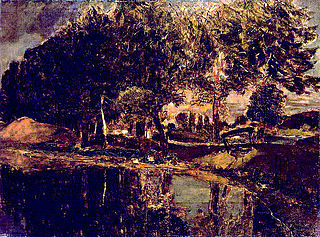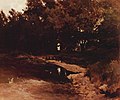At the Seddiner See near Kähnsdorf
At Seddiner See near Kähnsdorf is a painting by the Austrian painter Carl Schuch . The sketchy work shows in dark tones the isthmus between Lake Seddiner and Lake Kähnsdorfer in Brandenburg . The 60.5 × 82 cm picture, painted in oil on canvas , was created during a visit by Carl Schuch to his painter friend Karl Hagemeister , probably in 1880. Today the painting is in the Pomeranian State Museum in Greifswald .
Image description
The painting, mainly executed with rough brushstrokes, shows a lake in the lower foreground, the shoreline of which curves slightly to the lower right. The lake reflects in dark tones the trees standing on an isthmus in the center of the picture and partly the sky. This isthmus separates the Großer Seddiner See from the Kähnsdorfer See. The tops of a dense row of trees rise diagonally from the left edge of the picture to the top center, where the trees are partially cut off from the edge of the picture. Towards the right edge of the picture, two large single trees below their crowns allow a clear view of the second lake behind the isthmus, which can only be recognized as a horizontal narrow gray-blue stripe. Behind it, in the center of the picture, you can see the tree-lined shore of the second lake. A wooded hill forms the right end of this shoreline that lies behind the isthmus. On the left edge of the picture, an ocher-colored hill below the row of trees borders the isthmus. A little further to the center of the picture, small white colored areas indicate houses in a nearby village. In the right half of the picture, a weir can be seen as another prominent point on the isthmus.
While the trees are mostly kept in dark green and dark brown tones, the painter shows the sky from dark gray tones in the upper left corner to lighter blue-gray tones in the center and on the right edge of the picture. The rather sketchy painting bears the signature “CSchuch” in the lower right corner of the picture. However, this signature does not come from Carl Schuch himself, but was added by a third party.
About the creation of the painting
Originally from Vienna, Schuch had left his hometown after his apprenticeship in 1869 and settled in various artistic centers in Europe in the following years. In addition to Venice, Munich was one of his places of residence, from which he made extensive excursions. In the summer of 1873, Schuch met the painter Karl Hagemeister at the Hintersee near Berchtesgaden , who would later become his biographer. They then visited Vienna, Venice and Dresden together and then had a joint studio in Brussels. Living in Venice for six years from 1876, Schuch received an invitation from Hagemeister for the first time to Ferch an der Havel in 1878 , where Hagemeister had settled. Further visits followed in 1880 and 1881. During these three visits Schuch painted numerous paintings with motifs of the Havel landscape. According to Hagemeister, the pictures painted in the vicinity of Kähnsdorf were created in 1880. Carl Schuch expressed his wish to visit Kähnsdorf in a letter to Hagemeister dated March 30, 1880 from Venice, in which he announced his intention to paint landscapes: “That The only thing I have to do is color in the landscape. Be careful, this year we'll come to terms with it, then we'll see. Just make sure you find a suitable place; in an emergency that you can't find anything better than real scenic Kähnsdorf would be the best. "
In his biography of Carl Schuch, which was written more than 30 years after the painting was made, Hagemeister referred to the water in the foreground as the Seddiner See and the water in the background as the Kähnsdorfer See. Accordingly, the painter would have chosen the view from north to south. However, the art historian Roland Dorn doubts Hagemeister's description of the place, since Hagemeister and Schuch had already fallen out in 1884 and Hagemeister only dealt more intensively with the work of his former friend again after Schuch's death in 1903. It is therefore possible that the painter chose the view from the south and that the lake in the foreground is the Kähnsdorfer See and the Seddiner See is in the background. The houses that are in the picture to the left of the weir, which today has a different design, would therefore belong to the village of Kähnsdorf. On the other side of the weir there are still no houses near the bank. Hagemeister's own notes also speak in favor of this location. The jointly inhabited house in Kähnsdorf “was on a hill in the middle of fruit trees and fifty paces away from Lake Seddiner, which stretched from east to west. There was a second lake to the south-east, and both were separated by a narrow strip of land made of poplar, willow and birch. The small lake was very picturesquely enclosed with reeds and reeds and a view over it to the north showed the village in a beautiful silhouette, which was only small and without a church. ”Due to the lake level, which has fallen significantly since 1880, the two bodies of water are no longer connected. The weir drawn by Schuch is dry and the isthmus between the lakes is now wider than shown by Schuch. The historic post road Leipzig - Berlin ran along the isthmus .
His biographer Hagemeister sees models for the pictures painted by Schuch in Ferch and Kähnsdorf as follows: “The sequence of tones of the terrain, which lawfully follows the air, which throws the reflexes on the plans, is as consistent as with the old Dutch and Courbet . "
Classification in the work of Carl Schuch
River landscapes and lakes can be found in Carl Schuch's work during various creative periods. An early example of this is the painting Waldsee from 1872. The picture painted near Purkersdorf near Vienna shows a similar picture structure as Am Seddiner See near Kähnsdorf and has a similarly dark palette. The painting, on the other hand, is much more elaborate, as can be seen in the example of the reflections in the water or individual finely executed grasses. According to Hagemeister, Schuch had this picture with her when they first met at Hintersee in 1873. The painting Am Weßlinger See , created in 1876, testifies to another artist friendship. During his joint visit with Wilhelm Trübner , he got to know the landscape at the Weßlinger See and captured it in oil in the style of the Leibl circle .
In his picture, reed field with ducks , also painted around 1881 during a stay in Brandenburg, the row of trees in Am Seddiner See near Kähnsdorf is missing . Instead, these step back into the background and thus give a clear view of the landscape of the fence , which is kept in very dark tones despite the lack of shadow effects from the trees. The title Gewitterstimmung bei Ferch, which is also common for this picture , provides information about the gray tones that Schuch used when designing the sky. Possibly a similar weather situation was the starting point for the color treatment of the sky in Am Seddiner See near Kähnsdorf . Schuch's palette, on the other hand, is much lighter in his painting Schleuse bei Kähnsdorf , which was also made near Kähnsdorf , in which he reproduced an open landscape in summery colors.
After his stay in Paris at the beginning of the 1880s, Schuch was clearly under the influence of Courbet and his two-dimensional designs of color are reminiscent of paintings by Paul Cézanne . The painting Houses on the slopes of the field, Saut du Doubs , carried out near Le Locle in the Jura around 1886/88 shows a mill on the banks of the Doubs River . Again a landscape in dark tones is reflected in a body of water. Only a few color accents such as the white of the houses and the red of the roofs stand out from the gray tones of the surroundings. Schuch showed the white houses as accent points in Am Seddiner See near Kähnsdorf from 1880.
literature
- Gottfried Boehm, Roland Dorn, Franz A. Morat (eds.): Carl Schuch (1846–1903) . Exhibition catalog Städtische Kunsthalle Mannheim and Städtische Galerie im Lenbachhaus, Munich 1986, ISBN 3-89165-029-9 .
Individual evidence
- ↑ a b Boehm, Dorn, Morat: Carl Schuch (1846–1903) , page 224
- ↑ Boehm, Dorn, Morat: Carl Schuch (1846-1903) , pages 113-116
- ↑ Schuch cited in Boehm, Dorn, Morat: Carl Schuch (1846–1903) , page 89
- ↑ Boehm, Dorn, Morat: Carl Schuch (1846-1903) , pages 121-122
- ^ Hagemeister quoted in Boehm, Dorn, Morat: Carl Schuch (1846–1903) , page 224
- ↑ Georg Klünder: Investigation into the history of Wildenbruch . In: Blickpunkt Spezial , 2002, excerpt from Ev. Parish Wildenbruch ( Memento from May 31, 2009 in the Internet Archive )
- ^ Hagemeister cited in Boehm, Dorn, Morat: Carl Schuch (1846–1903) , page 70
- ^ Hagemeister quoted in Boehm, Dorn, Morat: Carl Schuch (1846–1903) , page 160
- ↑ Boehm, Dorn, Morat: Carl Schuch (1846-1903) , page 176
- ↑ Boehm, Dorn, Morat: Carl Schuch (1846-1903) , pages 232-234
- ^ Boehm, Dorn, Morat: Carl Schuch (1846–1903) , page 228
- ↑ Boehm, Dorn, Morat: Carl Schuch (1846–1903) , page 322





